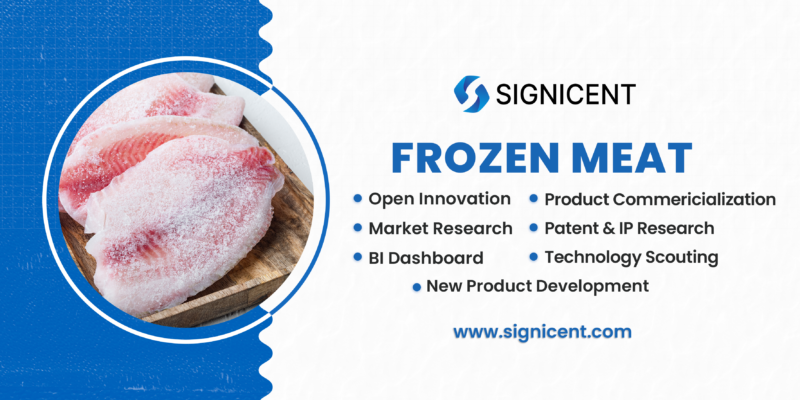The frozen meat/ food industry has seen tremendous growth. The technology scouting report on frozen meat area revealed solutions to technical challenges, information on industry standards, best practices, key companies & market trends.
Frozen foods usually face spoilage in moist conditions. There are primarily two processes of freezing food, one involves mechanical, and the other is based on cryogenic or better-called flash freezing. The freezing kinetics plays a critical role in keeping the quality as well as the industry standard of the food item intact. The freezing process helps in preserving the cellular structure. Cryogenic freezing is aggressively being used however innovative approaches are being tested to get the maximum out of this technology.
During the preliminary analysis we have identified few problems involved at various steps of frozen meat and exemplary solutions to such problems are shared in the frozen meat technology report.
Report on Problems with Frozen Meat
Problem Statements disclose the challenges associated with the frozen meat and packaging:
- The processed bacon slices suffer internal cracking, breaking, etc. when pressed to acquire the uniform shapes, especially treated at cold temperatures.
- The consumption of synthetic chemical compounds to control the lipid oxidation and to eliminate bacteria in the packaged meat.
Report on Solutions in Frozen Meat
To understand the industry challenges relating to frozen meat, Signicent technology experts go through thousands of scientific pieces of literature/ academic publications and patent literature based upon which viable solutions are as proposed :
- A meat processing device that can control the dimensions of the meat while minimizing the damage to the slab and the slices.
- The need for the use of natural antioxidants to improve the meat quality and to extend its shelf- life.
Internal Cracking
Gundlach & Rattmann Consulting LLC is aggressively working on a processing device that can control meat slab dimensions and minimize internal cracking as well as seam separation. It also prevents breaking during the pressing operation.
Device Innovation Report to preserve Frozen Meat
A meat processing device is designed to produce bacon slab dimensions. It is suitable for slicing by controlling both the width and thickness of the top/flank end and the bottom/brisket end during the smoking and heating process. It better conform to the desired slice dimensions needed in the finished package while minimizing damage to the slab and slices.
Advantages of the Technology
- The pork bellies become narrower and dimensionally more uniform after processing with the disclosed invention. Increasing the number of bellies on a trolley when hung closer while smoking.
- Improvized quality of the bacon slices is another proved advantage.
- Yield enhancement is definately improved manifolds.
Use of Preservatives & Antibiotics in Frozen Meat
In this section of the frozen meat technology report, the use of preservatives and antibiotics is discussed. Aizi Nor Mazila Ramli et al have worked aggressively in preservatives and antibiotics for frozen meat. The biggest concern is around animal welfare among consumers. When it comes to buying meat and poultry consumers see the label if it is accurate in its description. Also, the use of antibiotics and preservatives in meat production is of utmost concern.
Plant-Based Phenolic Molecules
For frozen meat plant-based, phenolic molecules can be used as alternative preservatives. When the use of chemicals is inevitable plant-based phenolic molecules are best to use. Recently, passion fruit (Passiflora edulis) peel powder extract has been used as a natural antioxidant and antibacterial for frozen meat.
Advantages Offered
The minimal or no use of chemical preservatives for frozen meat has opened the doors for the frozen meat market tremendously. Another advantage of plant-based phenolic molecules is enhanced antioxidant and antibacterial properties. Therefore, the shelf-life is increased with improved quality.
Signicent can help you to identify innovation trends and recent technological advancements to give direction to the R&D team.
Antimicrobial Wrapping / Packaging
Antimicrobial wrapping nanopaper with bacterial cellulose was formulated. The postbiotics incorporated BNC (P-BNC) films were optimized by response surface methodology and their antimicrobial activity against Listeria monocytogenes was examined. BNC with postbiotics at 21.21% concentration and 28 min impregnation time was chosen as an optimized P-BNC film.
P- BNC Filming Against TBA Values
Meat wrapped by P-BNC film (Postbiotics-Bacterial nanocellulose) displayed a significant decrease in total mesophilic and psychrophiles count and TBA values than the controls.
BNC (Bacterial Nanocellulose) can be considered as a proper carrier for the development of antimicrobial film using postbiotics of LAB for food application and an excellent carrier for different biomaterials.
Nanopaper Against Listeria monocytogenes
Nanopaper completely controlled Listeria monocytogenes in ground meat. The postbiotics addition significantly increased STB (strain to break) and decreased UTS (ultimate tensile strength).
Each year Signicent provides consultancy to hundreds of organizations to help transform their innovations to value.
Antimicrobial Meat Wrapping Nanopaper
Postbiotics of Lactobacillus plantarum was successfully incorporated in nanopaper. The incorporation of postbiotics in the BNC made changes in the porous morphology of substrate and established a coherent network of the BNC membrane with homogeneous and smooth surfaces, while it confirmed the effective enmeshing of postbiotics in the BNC film.
Biodegradable and compostable food packaging unit
A biodegradable food packaging unit from a molded or fluff pulp material with laminated multilayer. It comprises inner & outer cover layers. These layers comprise a biodegradable aliphatic polyester which is polyhydroxybutylhexanoate (PHBH).
The intermediate layer is made of biodegradable material and a functional layer. The barrier properties of the packaging enable its use in meat packaging. It prevents stains in the product caused by hemoglobin contained in the meat hence improving the visual appearance and shelf life of the product.
Bioactive edible and biodegradable films for cooked meat
The edible films were produced by the addition of T. cordifolia to the calcium alginate edible films as a bio‐active ingredient. This provides the antimicrobial and antibacterial properties and protects the Cooked meat. The lipid oxidation (TBARS – thiobarbituric acid reacting substances) and microbial spoilage (FFA, microbial counts) gets reduced (spoilage indicators). Improved the sensorial characteristics of the products during storage. This study reports for the first time the use of T. cordifolia as a novel additive for the development of bioactive edible and bio‐degradable films.

